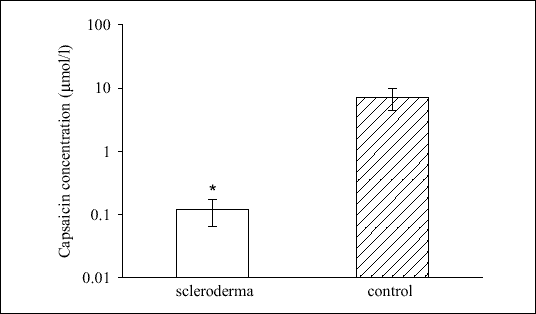The aim of this study was to investigate the cough sensitivity to capsaicin in patients with sclerodermia localized to the skin only, as opposed to the organ involvement in progressive systemic sclerosis. These patients had no respiratory symptoms (cough, dyspnoea, etc.), which may be present in other forms of the disease due to alterations and fibrosis of connective tissue in internal organs including the lung (9).
Subjects
The study population consisted of 12 patients (F/M; 7/5, mean age 55 years) with localized sclerodermia currently attending the Department of Dermatology, Jessenius Medical School at Martin with no clinical respiratory symptoms, normal spirometry and transfer factor (CO single breath test), and no history of acute respiratory infection (last 6 weeks) who were recruited consecutively. Twelve 12 non-allergic healthy subjects (F/M; 7/5, mean age 37 years) with normal pulmonary function constituted a control group. Based on a structured, interviewer-led questionnaire, each subject was asked about respiratory symptoms and a past and family history of bronchial asthma, allergic rhinitis, gastroesophageal reflux, cardiovascular diseases, metabolic diseases, ACE inhibitor treatment. All patients were examined at the same time of day. They attended the laboratory to undergo a cough reflex sensitivity test, spirometry and transfer factor (CO single breath test). The study was approved by the Ethics Committee of Jessenius Medical School and informed consent was obtained from all subjects after the purpose of the test had been explained.
Assessment of localized sclerodermia
Skin examination, specific and non-specific immunity were determined and skin biopsy was performed. Patients with localized sclerodermia were treated for their disease only topically with Excipial ointments/w/o, cremes, solutions or Balmandol bath (Spirig, Switzerland) - all not containing corticosteroids.
Assessment of cough sensitivity
Measurements of the cough threshold were carried out by progressively increasing concentrations of inhaled capsaicin, which was preceded by physiologic saline inhalation, according to the method reported by Fujimura et al. (10). Each subject inhaled an aerosol of capsaicin solution (0.024, 0.049, 0.098, 0.195, 0.39, 0.781, 1.562, 3.125, 6.25, 12.5, 25, 50, 100, 200 µmol/L). Two litres of aerosol were inhaled every 60 seconds by deep mouth breaths, with a nose clip in place, from a Pari Provokationstest I (Pari Werck, Germany). Increasing concentrations were inhaled until two or more coughs were elicited. Mass median diameter of the particle was 1.2 µm. Two medical technicians counted the number of capsaicin-induced coughs. Capsaicin cough threshold, the lowest concentration of capsaicin eliciting 2 or more coughs, was taken as an index of airway cough sensitivity.
Data analysis
The capsaicin cough threshold was expressed as a geometric mean value with 95% confidence intervals (CI) of the capsaicin concentration causing two or more coughs and was calculated for each group. Data were analysed by a non-parametric Mann-Whitney-Wilcoxon test and a value of P<0.05 was considered to be significant.
Cough sensitivity was 0.15 µmol/L (0.04 to 0.56 µmol/L) in 12 patients with localized sclerodermia and 4.96 µmol/L (2.50 - 9.85 µmol/L) in 12 healthy volunteers (P<0.002), which was a significant increase in the patients (Fig. 1).
 |
| Fig. 1. Cough sensitivity expressed as geometric mean and 95 % CI of capsaicin concentration inducing 2 or more coughs in patients with localized sclerodermia and healthy controls (*P<0.002 - compared with controls). |
The aim of this study was to evaluate the sensitivity of airway nerve-endings mediating cough in patients with localized sclerodermia (pathological process of the skin) without respiratory symptoms (cough, dyspnea, etc.). We found that cough sensitivity was significantly increased in the patients. Localized sclerodermia was used as a model of a pathological autoimmune process clinically manifested in the skin. But the spectrum of disease is wide, with localized and systemic forms. The process could be generalized with organ involvement and influence respiratory system function. Pulmonary interstitial fibrosis is involved in progressive systemic sclerosis (9). Cough sensitivity is increased in some respiratory diseases (2, 3, 6, 7). We can choose a model of a disease that is morphologically and clinically localized outside the respiratory tract, but it is known that it can be manifested in pulmonary parenchyma (9).
Our data suggest that a capsaicin cough test can show a functional change of airway afferent nerve-endings mediating cough during a sclerodermic process localized to the skin. Although very little is known about the sclerodermic process "spreading" to the airways and its detection by the capsaicin cough test, this observation is of interest and merits further investigation.
Acknowledgments: This work was supported by National Research Grant VEGA 1/9322/02.
- Morice AH, Higgins KS, Yeo WW. Adaptation of cough reflex with different types of stimulation. Eur Repir J 1992; 5: 841-847.
- Choudry NB, Fuller RW. Sensitivity of the cough reflex in patients with chronic cough. Eur Respir J 1992; 5: 296-300.
- Irwin RS, Boulet LP, Cloutier MM et al. Managing cough as a defense mechanism and as a symptom. A consensus panel report of the American College of Chest Physicians. Chest 1998; 114: Suppl. 2, 133S-181S.
- Widdicombe J. Airway receptors. Respir Physiol 2001; 125: 3-15.
- Pecova R, Frlickova Z, Pec J, Tatar M. Cough sensitivity in atopic dermatitis. Pulm Pharmacol Therap 2003; 16: 203-206.
- Doherty MJ, Mister R, Pearson MG, Calverley PMA. Capsaicin induced cough in cryptogenic fibrosing alveolitis. Thorax 2000; 55: 1028-1032.
- Lalloo UG, Lim S, DuBois R, Barnes PJ, Chung KF. Increased sensitivity of the cough reflex in progressive systemic sclerosis patients with interstitial lung disease. Eur Respir J 1998; 11: 702-705.
- Péčová R, Tatár M, Rozborilová E, Buchancová J. Cough sensitivity in patients with respiratory diseases (in Slovak). Stud Pneumol Phtiseol 1999; 59: 115-119.
- Habif TP. Clinical Dermatology - A Color Guide to Diagnosis and Therapy. St. Louis, Missouri, USA, C.V.Mosby Company, 1990, p. 756.
- Fujimura M, Kasahara K, Yasui M et al. Atopy in cough sensitivity to capsaicin and bronchial responsiveness in young females. Eur Respir J 1998; 11: 1060-1063.